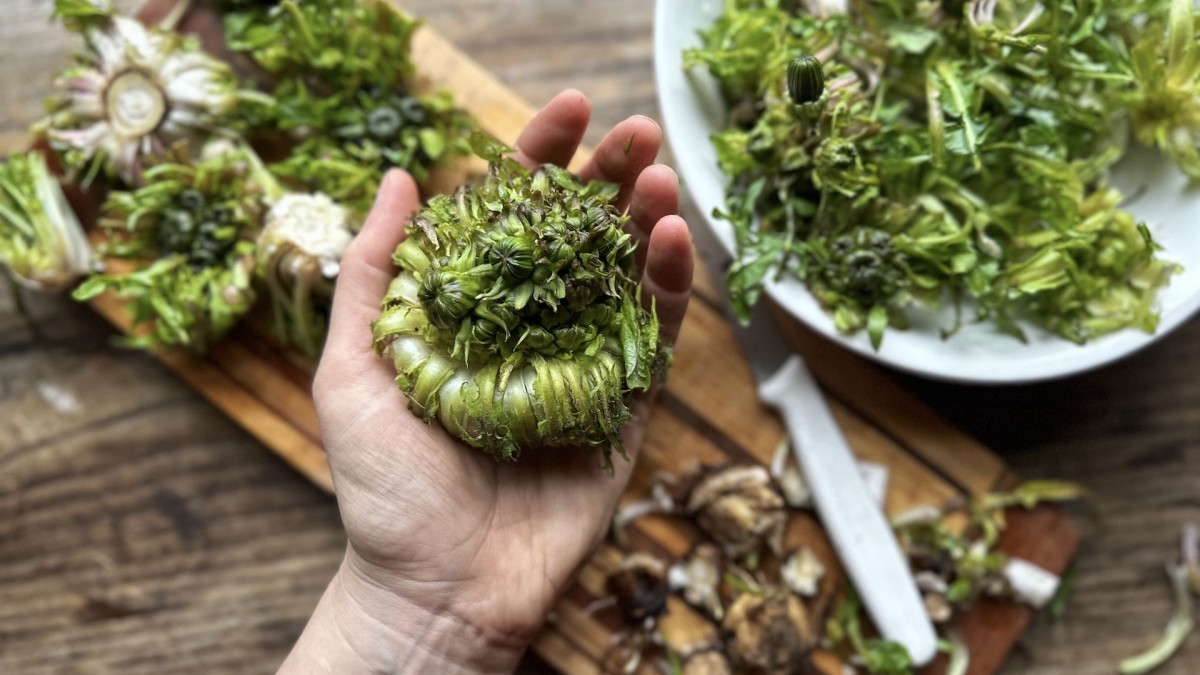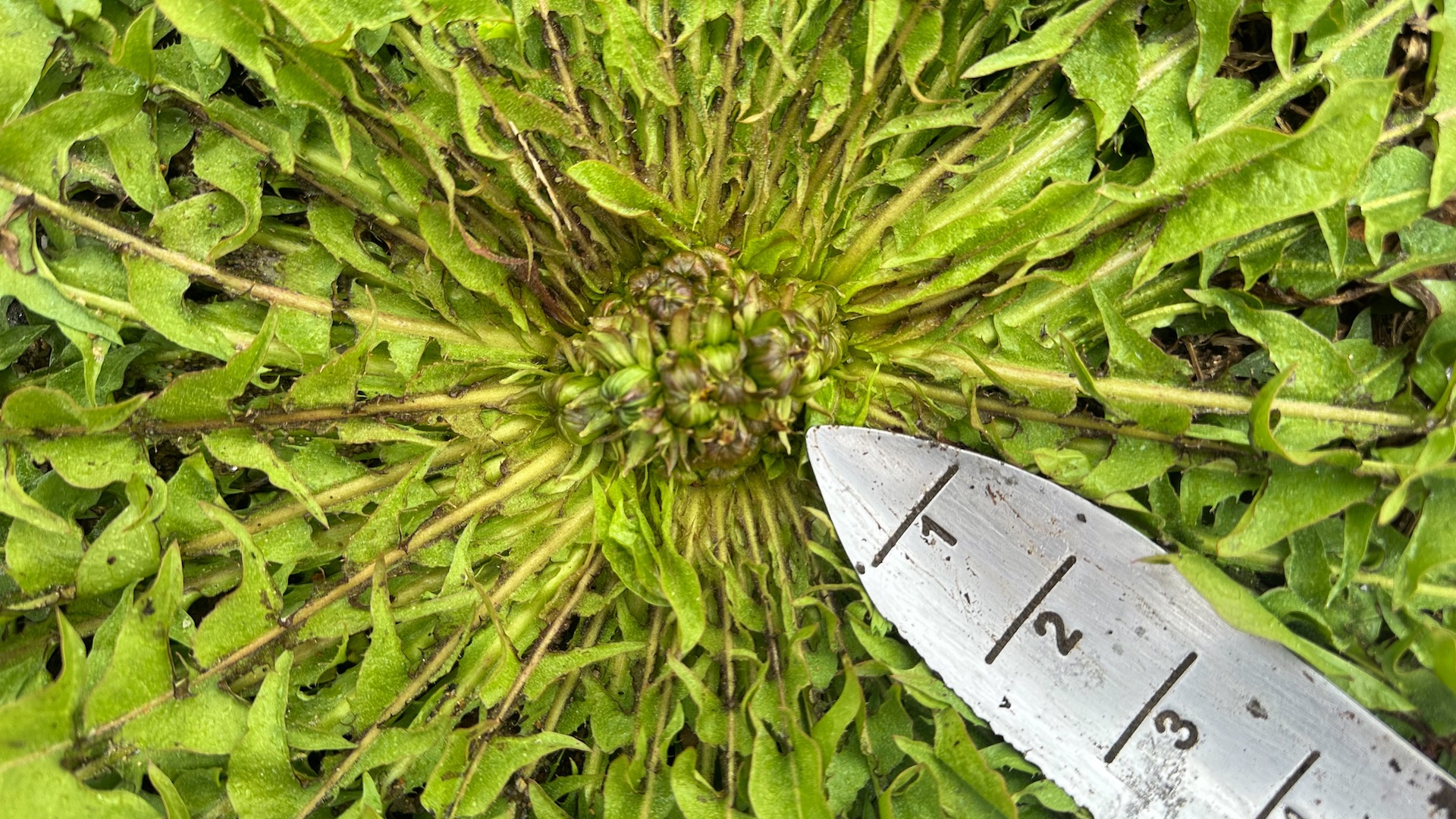
You might feel so familiar with dandelions that when you hear about them each spring, you’re immediately bored and want to move on to something new and sexy. You might have tried the leaves and thought they were too bitter or tried making tea with the roots to cleanse your liver but thought the flavor was nothing to write home about. But, I’d wager that you haven’t tried the heart, and if you ask me, there’s nothing sexier than a good heart.
I first learned about dandelion hearts (also called “crowns”) when I read Sam Thayer’s book, The Forager’s Harvest. I was skeptical, thinking I knew everything about dandelions, but Sam’s insistent enthusiasm for crowns won me over. I doubted that dandelions had anything left that could surprise me, but I followed his harvest and preparation instructions. I expected to taste the dandelion I already knew, but what I found seemed to be an entirely new vegetable.
The tender, buttery crowns rival artichoke hearts in texture and asparagus in flavor, but they win the rivalry for being free and likely only a few steps from wherever you’re standing. I was confused and delighted that something so sumptuous, living right under my nose, had eluded me for so long. It drove the truth home that there’s always something new to learn.
Best Season for Foraging Dandelion Crowns
Timing is essential for crown season and requires a watchful eye. Dandelions are, of course, easiest to spot when they’re showing their cheery, yellow flowers, but this means you’re too late.
The crown is only available after the basal rosette of leaves has reached full size, while the plant prepares to send up flowers, but the buds are still tightly packed at ground level in the center of the rosette, and the flower stems have not yet elongated. In Maine, this happens from the end of April through the end of May, depending on the location, and happens sporadically throughout the rest of the summer after yards and fields are mowed and begin to regrow.
Where to Find the Best Dandelion Hearts
Dandelions, a.k.a. taraxacum officinale, exist in every state in North America and tolerate a really wide range of conditions. But, to get the fattest crowns, you’ll want to focus on places where they thrive. For example, I like to walk on the edge of organic crop fields, gardens, and fertile meadows to find the choicest specimens.
These dandelions will have access to the nutrient-dense soil enjoyed by the cultivated crops and face less competition from other plants, which means you’ll find robust dandelions. I actually let dandelions grow in the walkways between my garden beds just so I have easy access to a good crown harvest.
There are always exceptions to this habitat preference, and I often find big crowns in unlikely places, so keep your eyes peeled all over town, but wherever you find them, make sure the area has not been treated with toxic chemicals and is not exposed to runoff or questionable water sources.

Tools for Foraging Dandelion Crowns
Once you find your dandy patch and the time is right, you’ll need one of three tools: a soil knife, a small blade that you don’t mind plunging into the dirt, or Sam Thayer’s tool of choice, a sharpened spoon. The sharpened spoon is a brilliantly effective crown digger, and any standard- to large-sized kitchen spoon will do.
You’ll want one with a sturdy neck that won’t bend under pressure. To sharpen it, clamp the handle in a vice and run a metal file over the edge of the spoon from the widest point toward the tip. Repeat on both sides until the tip and edges are moderately sharp to the touch.
How to Harvest Dandelion Heart
With your tool of choice, you have a few options for harvesting. Sometimes I harvest the leaves along the crowns or the roots, but sometimes I don’t. Often, where you find dandelions—in someone’s yard or a farmer’s field—digging roots may not be welcome, so I’ll focus on above-ground parts. Locate the center of the rosette and part the leaves with your fingers so you can see the base of the plant. With the leaves parted with one hand and the tool in your dominant hand, aim the tip of the spoon or soil knife at the center of where you imagine the root to be, just barely below the soil surface, and push.
If your tool is sharp and your aim is good, you can pop through the top of the root in one jab, but more often than not, the tool will glance off to one side of the root, where you then use the side cutting edge to saw through the top of the root from the side. Essentially, you’re aiming directly at soil level, where the root meets the base of the aerial portions, but it’s better to aim a little lower and cut into the root, rather than aiming too high and cutting into the crown itself.
Once you’ve cut through the root, you can lift the whole plant, leaving the root in the ground. At this point, I like to brush away excess dirt and peel away the outermost leaves to keep things clean in the basket. If I’m keeping the leaves to eat or dry for tea, I’ll put the whole rosette in my basket. If I’m only after the crowns, I’ll trim the leaves off about two to three inches above the base. Depending on size, which varies greatly, you’ll want between three and ten crowns per person for a good portion as a side vegetable. With average-sized crowns, six is a good portion. Sometimes, you’ll get a monster that’s almost a whole meal in itself.

Preparing and Cooking Dandelion Crown
When you get your crowns home, trim the rest of the root up to the white base of the crown, but don’t cut into the crown above the leaf bases, or the whole thing will come apart. Put your crowns into a bowl of water, rub off any visible clinging dirt, and swish the crowns around vigorously with your hands. Then, lift them out (don’t dump them upside down), change the water, and repeat this until the water is clear after agitating. Clean these as diligently as you would a basket of morels—it’s worth your time.
When you’re ready to cook them, boil enough water so all of your crowns can be submerged. Salt your water generously. Put the crowns in the pot upside down so any leftover dirt will fall out and settle on the bottom of the pot. Cook at a moderate boil for 5 minutes, lift the crowns out, and blanch in cold water. Drain and dump the water from your pot, rinse quickly, and return to low heat. If your pot isn’t big enough to fit the crowns in a single layer, you’ll need to move to a wider pot or pan. Add enough butter to fully coat the crowns— generally half a stick or more. Once the butter is melted, return the crowns and simmer on low for four minutes, turning and swirling so they get fully coated. Dish out onto plates, finish with a squeeze of lemon, and enjoy them while hot.
I’ve eaten crowns this way for years and didn’t really think it could be improved upon, but two years ago, I decided to substitute crowns for asparagus in this recipe for pan roasted wild turkey and proved myself wrong. As evidence of how highly I regard this meal, last night was my birthday—I could’ve eaten anything in the world—and I chose this.




Conversation